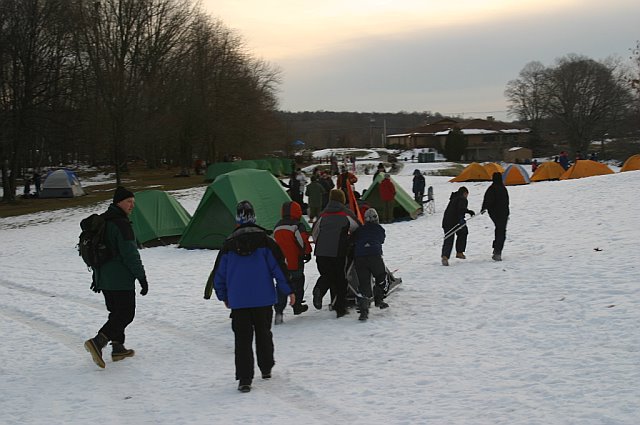Cold Camping
Tips for staying warm on a winter campout
|
Daytime |
|
|
Overall |
Layers, layers, layers! That includes head, body, hands and feet. Start with polypropylene, then fleece or wool combination. The outermost layer should be windproof and waterproof. |
|
Head |
Most of your body heat is lost through the head, so be sure to wear a Fleece or wool hat. For really cold and windy weather, wear a balaclava and a wool hat and your hood. For 20 degrees F or less, keep the wind off your face and breathe through the balaclava. |
|
Body |
Start with long underpants and long undershirt, then fleece pants and a fleece shirt. When it's really cold, add a fleece vest and snow pants. Jackets or parkas should have hoods. The outer shell which should be waterproof and windproof. |
|
Hands |
Wear glove liners, gloves, and if it's very cold, outer mitts. A lightweight waterproof glove comes in handy for setting up tents and cooking. |
|
Feet |
Socks - wear polypropylene under wool. The
colder it is the more socks you wear. First a thin,
polypropylene sock, then a medium weight wool sock, then a big,
thick wool sock, then the boot liners, and lastly waterproof boots.
|
|
Eyes |
In extreme cold or during snowstorms, wear ski goggles or wrap-around sunglasses |
| DO NOT |
DO NOT wear cotton- Cotton Kills in the Cold. This
includes jeans and even old style scout uniforms, cotton
underwear, and shirts. Cotton is a very poor insulator
when wet. DO NOT wear sneakers. You will be sent back home if you try to come cold weather camping only wearing sneakers |
|
Before Sleeping |
|
|
|
Change ALL clothes before going to bed. Everything must be clean and dry. Anything you've worn during the day will have slight amounts of perspiration and if it stays near your skin you'll get cold. |
| Don't go to bed cold. Do jumping jacks or run in place to heat your body up. 20 fast pushups in your tent will work too. | |
| Eat a power snack between 30 min to an hour before bed. Fats are good. A piece of cheese is an excellent choice. | |
| Drink hot cocoa or decaffeinated tea. This might make you have to go to the bathroom in the middle of the night, but it's important that you are not dehydrated. If you are dehydrated, you cannot generate the heat you need | |
|
Sleeping Clothing |
|
|
Overall |
Layers, layers, layers! (The same as during the day.) That includes head, body, hands and feet. Start with polypropylene, then fleece or wool combination. |
|
Head |
Wool hat or balaclava |
|
Body |
Polypropylene, then fleece or wool. Hot water in Nalgene bottle will help keep you warm if you keep it near your stomach. |
|
Hands |
Gloves- polypropylene liners or fleece gloves or both |
|
Feet |
Chemical hand warmers can be put in the bottom of your sleeping bag. |
| DO NOT | DO NOT wear cotton |
| Bedding and Sleeping Area | |
|
B.E.F.A. |
For real cold, your bed should be a sleeping Bag, on top of an Emergency Foil Blanket, on top of a Foam pad, on top of an Air mattress. To stay warm, you need your "BEFA". The foil blanket reflects heat back toward you. The foam pad insulates and makes sleeping comfortable, the air mattress adds comfort but not warmth. Foam pads should be closed cell foam because they don't absorb water. Put all your extra clothes under your foam pad or over your sleeping bag for additional insulation. Make sure you don't roll off your foam pad! |
|
Sleeping bag |
The bag should be rated for the lowest
expected temperature- a 0 degree bag is a great idea. If it's not,
use a fleece or silk blanket as an extra liner inside your
sleeping bag. A mummy style bag is warmer than a rectangular
since there is less space for your body to heat. A down
bag may keep you as warm as a fiber bag but only if it is dry. A
wet down bag is ineffective and can do more harm than good. Use
an appropriately temperature rated fiber bag, or take extra
steps to make sure your down bag stays dry. |
|
Tent or Lean-to |
Ventilate your tent so your breath doesn't condense but don't let wind howl through it. If sleeping in a lean-to, rig your poncho or ground cloth to keep wind and drafts off you. |
Hypothermia
Tell a leader immediately if you recognize the signs and symptoms of hypothermia:
- Shivering
- Slurred speech
- Abnormally slow breathing
- Cold, pale skin
- Loss of coordination
- Fatigue, lethargy or apathy
or notice if someone has the "umbles"
- stumbles
- mumbles
- fumbles
- grumbles
For more hypothermia information:
- Hypothermia & Dehydration (Gatorade and cheese)
- Cold Weather and Hypothermia (quick overview)
- Hypothermia -Physiology, Signs, Symptoms and Treatment Considerations (Detailed info from Search and Rescue)

